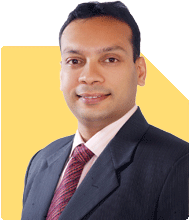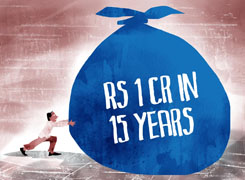
Sir, My age is 56 years. I have taken VRS in November 2023.I am getting a monthly pension of Rs 50000/-I am also getting a monthly rent of Rs27000/- from my rented property.
My Mutual fund value as on15 October is Rs
2.4cr.My shares value as on same date is Rs 82 lakhs. I have an investment of Rs 30 lakhs in Senior citizen scheme, as i am eligible for it being voluntary retired from Gov service.
I have an investment of Rs 60lakhs in Gov bonds, Postal MIS and bank and company Fixed deposits.
My wife is working and she is having Rs 1.2 Lakhs in Mutual funds and around Rs55 lakhs in shares as per value dated 15 October.
She is also having around 20laks in Bank, company fixed deposit and bonds.
She earns a monthly salary of Rs 1.2 lakhs.
She also has a rental income of Rs21000/- per month.
We live in our own house.Son is settled in London and working. Will get married in 2 years.
Our monthly expenses are around Rs 1.5 lakhs. We also have a medical policy of Rs 5 lakhs with a top up of Rs16 lakhs. Plus wife is also covered under CGHS including me.
Kindly let me know if we can maintain our same life style for the next 25 years.
My wife is also thinking of taking VRS after 3 years. She will also be eligible for pension.
Ans: You have a strong financial base with diverse income sources and substantial investments. Both you and your wife are in stable positions, and your ability to plan ahead shows that you are well-prepared for retirement and the years beyond.
In this detailed assessment, we will explore your finances and future planning from a 360-degree perspective to ensure that you can comfortably maintain your lifestyle for the next 25 years, even after your wife takes VRS and your son settles in his life.
Income Overview
You currently have multiple reliable income streams, which provide stability and flexibility. Let’s break down each source of income to see how they contribute to your financial health:
Pension: Your pension of Rs 50,000 per month is a consistent and reliable source of income. It will continue to be paid throughout your lifetime, making it a foundation of your financial security.
Rental Income: You are earning Rs 27,000 from your rented property, and your wife earns Rs 21,000 from hers. Combined, this provides an additional Rs 48,000 per month. Rental income can often be a stable and inflation-adjusted source, as rental rates tend to increase over time.
Wife's Salary: Your wife currently earns Rs 1.2 lakh per month. This is a significant portion of your total household income. She plans to take VRS in three years, and her pension will replace this salary at that point.
Investment Portfolio
Your combined investment portfolio is substantial, which gives you the flexibility to draw down from it in the future if needed. Here is a detailed evaluation of your assets:
Mutual Funds: You have Rs 2.4 crore invested in mutual funds. Mutual funds are a great way to grow wealth, particularly when invested in actively managed funds. These funds are handled by professional fund managers who actively manage the portfolio to optimize returns while managing risk. Active management also allows the fund to navigate market volatility more effectively than index funds, which passively track the market.
Shares: You have Rs 82 lakh invested in direct shares, while your wife holds Rs 55 lakh. Stocks, being direct investments, come with the potential for higher returns but also higher risks. It is important to keep track of market conditions and regularly review the performance of your shares to ensure that your portfolio aligns with your financial goals.
Fixed Income Investments: You have Rs 30 lakh in a Senior Citizen Scheme, and Rs 60 lakh in a mix of government bonds, Postal MIS, and fixed deposits. Your wife has an additional Rs 20 lakh in bank and company fixed deposits and bonds. These fixed-income investments provide stability and predictability in your portfolio, balancing out the riskier equity investments.
Monthly Expenses
Your household expenses amount to Rs 1.5 lakh per month. Given your combined current income of Rs 2.18 lakh (pension, rental income, and wife’s salary), you are comfortably covering your expenses with room to spare. This excess income can be reinvested or saved for future needs.
Medical Insurance Coverage
You and your wife have comprehensive medical coverage, which is critical for long-term financial security:
Medical Insurance: Your medical policy covers Rs 5 lakh with a top-up of Rs 16 lakh. This gives you Rs 21 lakh of coverage, which should be sufficient for most medical emergencies. Medical inflation is rising in India, so this coverage is a crucial safety net.
CGHS: Your wife’s Central Government Health Scheme (CGHS) coverage includes both of you. CGHS is known for providing broad coverage, including outpatient treatment, specialist care, and hospitalization at minimal cost. This further reinforces your medical security.
Future Cash Flow After Wife’s VRS
In three years, your wife plans to take VRS and will be eligible for a pension. Let’s assess how this will affect your financial situation:
Wife’s Pension: While the exact pension amount is not specified, let’s assume a conservative estimate of Rs 50,000 per month. This, combined with your pension of Rs 50,000, will bring your total pension income to Rs 1 lakh per month.
Rental Income: Your combined rental income of Rs 48,000 will continue, assuming no significant changes in tenant occupancy or property maintenance costs.
Total Monthly Income After VRS: After your wife’s VRS, your total monthly income from pensions and rental properties will be Rs 1.48 lakh. This will be slightly below your current monthly expenses of Rs 1.5 lakh, but investment income from mutual funds, shares, and fixed-income products will more than cover the shortfall.
Investment Income Projection
To fill the gap between your expected income after your wife’s VRS and your expenses, you can rely on the income generated by your investments. Here’s how your portfolio can contribute to maintaining your lifestyle:
1. Mutual Fund Returns
You have Rs 2.4 crore invested in mutual funds. Assuming a conservative 8% annual return, this will generate Rs 19.2 lakh per year, or Rs 1.6 lakh per month.
Your wife’s mutual fund investment of Rs 1.2 lakh is relatively small but will still contribute to your overall portfolio growth.
2. Share Dividends and Growth
Your Rs 82 lakh in shares and your wife’s Rs 55 lakh can potentially provide both capital appreciation and dividend income.
Dividend-paying stocks can offer a regular income stream. However, the amount will depend on the specific companies in your portfolio and their performance. You might consider holding a balanced mix of high-growth and dividend-paying stocks for steady income and capital appreciation.
3. Fixed Income Investments
Your Rs 60 lakh in fixed deposits, government bonds, and Postal MIS, along with your wife’s Rs 20 lakh in similar investments, provide stable and predictable returns. These instruments are ideal for ensuring capital preservation and generating interest income. Depending on the interest rate (currently around 6-7% in India), this can provide Rs 4.8-5.6 lakh annually or Rs 40,000-46,000 per month.
Tax Considerations
Tax efficiency will be an important part of your financial planning, especially when you start drawing on your investments. Let’s explore the tax rules that apply to your current portfolio:
1. Mutual Funds
Long-Term Capital Gains (LTCG): Under the new tax rules, LTCG on equity mutual funds above Rs 1.25 lakh is taxed at 12.5%. Given the size of your portfolio, plan withdrawals carefully to minimize tax liabilities.
Short-Term Capital Gains (STCG): STCG is taxed at 20%. Be mindful of the holding period when making withdrawals to avoid short-term gains tax.
Debt Mutual Funds: Debt mutual funds are taxed as per your income tax slab for both LTCG and STCG. Since you are in a higher tax bracket, this should be considered when making decisions about debt fund investments.
2. Direct Shares
LTCG on Shares: Similar to mutual funds, LTCG above Rs 1.25 lakh from shares will be taxed at 12.5%. As your shareholdings are substantial, careful planning around sales is crucial to manage your tax burden.
Dividend Taxation: Dividends are now taxed as per your income tax slab. This means that dividend income from your shares will be added to your total income and taxed accordingly. This is an important consideration when selecting stocks, especially if you are relying on dividends for income.
Portfolio Rebalancing
Over time, you will need to rebalance your portfolio to ensure it continues to meet your goals. As you approach and enter full retirement, you may want to shift some of your investments into lower-risk options while still maintaining growth potential. Here are some strategies for rebalancing:
Reduce Equity Exposure Gradually: While equities provide higher returns, they are also more volatile. As you age, consider gradually shifting some of your equity investments into more stable, income-generating options such as debt mutual funds or government bonds.
Increase Fixed Income Allocation: As you approach full retirement, increasing your allocation to fixed income products can provide a more predictable income stream. Your investments in Postal MIS, Senior Citizen Schemes, and fixed deposits already provide a strong foundation for this.
Long-Term Healthcare Planning
Your current medical insurance coverage is adequate for now, but as healthcare costs continue to rise, it’s important to periodically review your coverage:
Increase Health Coverage: Medical inflation is growing at a rate of 10-15% per year in India. While your Rs 21 lakh insurance cover is strong today, consider increasing it in the future to ensure it keeps up with rising healthcare costs.
Evaluate Critical Illness and Long-Term Care Insurance: As you age, you may want to consider adding a critical illness policy or long-term care insurance to your portfolio. These policies provide additional coverage for serious health conditions and long-term care needs, which could otherwise eat into your retirement savings.
Final Insights
You are in an excellent financial position to maintain your current lifestyle for the next 25 years. Your diversified portfolio, combined with your income sources, ensures a stable cash flow even after your wife takes VRS in three years. The key to maintaining this stability lies in proper tax planning, portfolio rebalancing, and ensuring your healthcare needs are adequately covered.
Given your financial assets, you can afford to enjoy your retirement with confidence. By regularly reviewing your investments and making small adjustments as needed, you will ensure that you continue to meet your financial goals without compromising your quality of life.
Best Regards,
K. Ramalingam, MBA, CFP,
Chief Financial Planner,
www.holisticinvestment.in
https://www.youtube.com/@HolisticInvestment
























